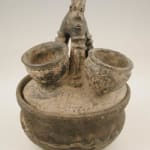Yoruba Terracotta Altar Vessel, 19th Century CE - 20th Century CE
Terracotta
7.5 x 10.5
PF.4801
Further images
The visual representation of deities must fall somewhere between the recognizably human and pure abstraction. The face on the handle of this vessel looks out as if from another world;...
The visual representation of deities must fall somewhere between the recognizably human and pure abstraction. The face on the handle of this vessel looks out as if from another world; and yet he appears quite human and compassionate. The deity Esu is depicted on divination trays as the divine mediator, a being who is guardian of the ritual process. In this sense the deity on the handle hovers above the offerings placed in the twin cups and in the central bowl. The rough markings on the lid, combined with the elemental quality of the clay, are like the earth itself with its wild vegetable growth. The deity then watches over the ritual of making offerings; he is part of the process and also aloof as appropriate to a spiritual entity. The cups may have contained kola nuts which are presented as a sign of peace and welcome to guests. They are also used to communicate with otherworldly forces, deities who are 'welcomed' and encouraged by the power of such vessels to bring good fortune and well-being to everyone.









